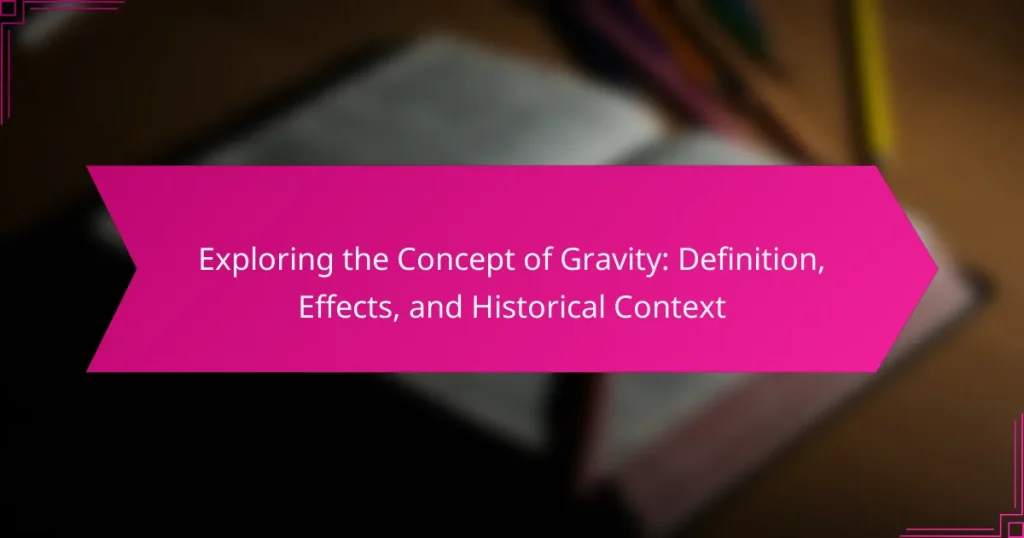Gravity is a fundamental force that attracts objects with mass toward one another, influencing the motion of celestial bodies and the structure of the universe. The concept of gravity has evolved from early philosophical views to scientific definitions established by Isaac Newton’s law of universal gravitation and later expanded by Albert Einstein’s theory of general relativity, which describes gravity as a curvature of spacetime. Current research challenges include understanding dark energy and dark matter, which constitute a significant portion of the universe’s mass-energy content, as well as reconciling general relativity with quantum mechanics. Advancements in technology, such as space-based observatories, and collaborative interdisciplinary efforts are essential for further exploration of gravity and its implications in modern physics.

What is the concept of gravity?
Gravity is a fundamental force that attracts objects with mass toward one another. It governs the motion of planets, stars, galaxies, and even light. Isaac Newton first defined gravity in the 17th century with his law of universal gravitation. This law states that every mass attracts every other mass with a force proportional to the product of their masses and inversely proportional to the square of the distance between them. Albert Einstein later expanded this concept with his theory of general relativity. According to this theory, gravity is not just a force but a curvature of spacetime caused by mass. This has been validated through observations, such as the bending of light around massive objects. Gravity is essential for the structure of the universe, influencing the orbits of celestial bodies and the formation of galaxies.
How is gravity defined in physics?
Gravity is defined in physics as the force that attracts two bodies toward each other. This force is proportional to the mass of the objects involved. It also decreases with the square of the distance between their centers. Isaac Newton formulated the law of universal gravitation in the 17th century. He described gravity as a force that acts at a distance. Albert Einstein later refined this understanding with his theory of general relativity. He proposed that gravity is the curvature of spacetime caused by mass. This modern definition aligns with observations of gravitational effects in the universe.
What are the fundamental principles of gravity?
Gravity is a fundamental force that attracts two bodies toward each other. It is proportional to the mass of the bodies and inversely proportional to the square of the distance between them. This relationship is described by Isaac Newton’s law of universal gravitation. Newton’s law states that every mass attracts every other mass in the universe. The force of gravity governs the motion of planets, stars, galaxies, and even light. Einstein’s theory of general relativity further explains gravity as the curvature of spacetime caused by mass. This theory has been validated through various experiments, including the bending of light around massive objects. Gravity is essential for the structure of the universe and the formation of celestial bodies.
How does gravity differ from other forces?
Gravity is a fundamental force that differs from other forces primarily in its universal nature and range. Unlike electromagnetic and nuclear forces, gravity acts on all masses, regardless of their size or distance. It has an infinite range, meaning its influence can be felt across vast distances in space. Gravity is always attractive, pulling objects toward one another, whereas other forces can be either attractive or repulsive. For example, electromagnetic forces can repel like charges and attract opposite charges. Additionally, gravity is significantly weaker than other forces, such as the strong nuclear force, which binds protons and neutrons in an atomic nucleus. This difference in strength affects how gravity operates in the universe, making it the dominant force at large scales, such as in planetary and galactic systems. The inverse-square law governs gravity, meaning its strength decreases with the square of the distance between two masses. This law is a key distinction, as other forces may not follow the same pattern. Overall, gravity’s unique characteristics set it apart from other fundamental forces in the universe.
What are the effects of gravity on objects?
Gravity exerts a force that attracts objects toward one another. This force is responsible for keeping planets in orbit around stars. It causes objects to fall toward the Earth when dropped. The acceleration due to gravity on Earth is approximately 9.81 m/s². Gravity affects the motion of objects, influencing their speed and trajectory. It also impacts the shape of celestial bodies, causing them to be spherical. Additionally, gravity plays a role in the tides on Earth, driven by the gravitational pull of the Moon. The effects of gravity are fundamental to understanding physics and the universe.
How does gravity influence motion and behavior of celestial bodies?
Gravity is the force that attracts celestial bodies toward each other. It governs the orbits of planets around stars and moons around planets. The strength of gravity depends on the mass of the objects and the distance between them. For example, the Sun’s gravity keeps the Earth in orbit. This gravitational pull affects the speed and path of celestial bodies. It also influences tidal forces on Earth caused by the Moon’s gravity. The behavior of galaxies is shaped by gravitational interactions among their stars. Observations, such as the motion of planets, confirm gravity’s role in celestial dynamics.
What are the implications of gravity on Earth and daily life?
Gravity is a fundamental force that affects all objects on Earth. It keeps us grounded and influences our daily movements. Gravity impacts the way we walk, run, and interact with our environment. It also governs the behavior of fluids, affecting how water flows and how objects sink or float.
In terms of health, gravity affects our physiology. It influences blood circulation and muscle strength. Without gravity, humans can experience health issues, as seen in astronauts during space missions.
Gravity also plays a critical role in weather patterns. It affects air pressure and the movement of weather systems. Furthermore, gravity is essential for the stability of structures and buildings. Engineers must account for gravitational forces when designing safe constructions.
Overall, gravity is a constant presence in our lives, shaping our experiences and the physical world around us.
Why is understanding gravity important in science?
Understanding gravity is crucial in science because it governs the motion of objects in the universe. Gravity affects everything from falling apples to the orbits of planets. It is a fundamental force that shapes the structure of galaxies and the universe itself. The laws of gravity, formulated by Isaac Newton and later refined by Albert Einstein, explain how mass attracts mass. This understanding allows scientists to make accurate predictions about celestial movements. For instance, Newton’s law of universal gravitation can predict the trajectory of a spacecraft. Additionally, gravity plays a key role in fields like astrophysics, engineering, and meteorology. Understanding gravity helps in developing technologies such as satellites and navigation systems.
How does gravity relate to other scientific concepts?
Gravity is a fundamental force that interacts with other scientific concepts such as mass, energy, and spacetime. It is the force that attracts two bodies towards each other based on their masses. The relationship between gravity and mass is described by Newton’s law of universal gravitation. This law states that the gravitational force increases with greater mass and decreases with distance.
In the context of energy, gravity influences potential energy in objects. An object’s potential energy increases as it is raised against the gravitational pull. Additionally, gravity plays a crucial role in the theory of general relativity. Einstein’s theory describes gravity as the curvature of spacetime caused by mass. This relationship explains phenomena such as the bending of light around massive objects.
Furthermore, gravity is essential in understanding planetary motion and orbits. The gravitational pull of celestial bodies governs the movement of planets, moons, and satellites. It also affects tides on Earth due to the gravitational interaction with the Moon and the Sun.
Overall, gravity is interconnected with mass, energy, and spacetime, forming the foundation for various scientific principles and theories.
What role does gravity play in the universe’s structure?
Gravity is the fundamental force that shapes the universe’s structure. It governs the attraction between masses, influencing the formation and behavior of celestial bodies. Gravity causes galaxies to cluster and shapes the large-scale structure of the universe. It holds stars in orbit around galaxies and planets in orbit around stars. The distribution of mass in the universe is determined by gravitational interactions. Observations show that gravity affects the motion of galaxies and the expansion of the universe. The presence of dark matter, which interacts through gravity, further demonstrates its role in cosmic structure. Gravity is essential for the stability and evolution of the universe.

What historical context surrounds the study of gravity?
The study of gravity has evolved significantly throughout history. Early thinkers like Aristotle believed gravity was a force that pulled objects toward their natural place. In the 17th century, Galileo Galilei challenged this view by conducting experiments that demonstrated the uniform acceleration of falling objects. Isaac Newton further advanced the understanding of gravity in 1687 with his publication of “Philosophiæ Naturalis Principia Mathematica.” He formulated the law of universal gravitation, stating that every mass attracts every other mass. This theory provided a mathematical framework for understanding gravitational forces. In the 20th century, Albert Einstein revolutionized the concept with his theory of general relativity. Einstein proposed that gravity is the curvature of spacetime caused by mass. Each of these historical developments contributed to the modern understanding of gravity as a fundamental force in the universe.
Who were the key figures in the development of gravity theory?
Isaac Newton and Albert Einstein were key figures in the development of gravity theory. Newton formulated the law of universal gravitation in 1687. This law described gravity as a force that attracts two bodies towards each other. Einstein later developed the general theory of relativity in 1915. His theory redefined gravity as the curvature of spacetime caused by mass. Both contributions fundamentally changed our understanding of gravity. Newton’s work laid the groundwork for classical mechanics. Einstein’s theories expanded the concept to include relativistic effects.
What contributions did Isaac Newton make to our understanding of gravity?
Isaac Newton formulated the law of universal gravitation. This law states that every mass attracts every other mass with a force proportional to the product of their masses and inversely proportional to the square of the distance between their centers. Newton’s work was published in “Philosophiæ Naturalis Principia Mathematica” in 1687. He introduced the concept of gravitational force as an attractive force acting at a distance. This was a revolutionary idea at the time. Newton’s equations allowed for the prediction of planetary motions. His insights laid the groundwork for classical mechanics. Newton’s contributions fundamentally changed our understanding of gravity and motion in the universe.
How did Albert Einstein’s theory of relativity change the perception of gravity?
Albert Einstein’s theory of relativity fundamentally changed the perception of gravity by redefining it as a curvature of spacetime rather than a force. Prior to this theory, gravity was understood through Newton’s laws as a force acting at a distance. Einstein proposed that massive objects like planets and stars warp the fabric of spacetime around them. This curvature affects the motion of other objects, causing them to follow curved paths.
The implications of this theory were profound. It explained phenomena such as the bending of light around massive objects, known as gravitational lensing. Observations during a solar eclipse in 1919 provided empirical evidence for this effect, supporting Einstein’s predictions.
Moreover, the theory introduced the concept of gravitational time dilation, where time moves slower in stronger gravitational fields. This was later confirmed through experiments involving precise atomic clocks at different altitudes. Overall, Einstein’s relativity shifted the understanding of gravity from a simplistic force to a complex interaction within the framework of spacetime.
What major experiments have shaped our understanding of gravity?
Major experiments that have shaped our understanding of gravity include Galileo’s inclined plane experiments. Galileo demonstrated that objects fall at the same rate regardless of their mass. His findings challenged Aristotelian physics, which claimed heavier objects fall faster. Isaac Newton’s apple experiment further developed this understanding. Newton formulated the law of universal gravitation, explaining gravitational attraction between masses. Cavendish’s experiment in 1798 measured the force of gravity between masses. This provided the first accurate measurement of gravitational constant. Einstein’s theory of general relativity revolutionized gravity, describing it as the curvature of spacetime. These experiments collectively transformed our comprehension of gravitational forces and their implications.
What were the outcomes of early gravity experiments?
Early gravity experiments established foundational principles of gravitational force. Isaac Newton’s experiments led to the formulation of the law of universal gravitation. This law states that every mass attracts every other mass with a force proportional to the product of their masses. Galileo’s experiments demonstrated that objects fall at the same rate regardless of their mass. These findings debunked earlier theories that heavier objects fall faster. The outcomes of these experiments laid the groundwork for classical mechanics. They also influenced later scientific advancements in physics and astronomy.
How do modern experiments continue to explore gravitational theories?
Modern experiments explore gravitational theories through advanced technologies and methodologies. These include gravitational wave detectors like LIGO and Virgo. They measure ripples in spacetime caused by massive cosmic events. Additionally, satellite missions such as GRACE monitor Earth’s gravitational field variations. These variations provide insights into mass distribution on Earth. Experiments also involve testing general relativity under extreme conditions. Observations of black holes and neutron stars challenge existing theories. Quantum gravity experiments aim to unify quantum mechanics and general relativity. Each of these approaches contributes to a deeper understanding of gravity’s fundamental nature.
How has the concept of gravity evolved over time?
The concept of gravity has evolved significantly over time. Initially, Aristotle believed gravity was a force proportional to an object’s weight. His view dominated for centuries until the Renaissance. In the 17th century, Sir Isaac Newton formulated the law of universal gravitation. Newton described gravity as an attractive force between masses. This framework explained planetary motion and terrestrial phenomena. In the 20th century, Albert Einstein introduced the theory of general relativity. Einstein proposed that gravity is the curvature of spacetime caused by mass. This theory refined our understanding, especially in extreme conditions. Modern physics continues to explore gravity, including its role in quantum mechanics.
What were the major milestones in the history of gravity research?
The major milestones in the history of gravity research include several key developments. In 1687, Isaac Newton published “Philosophiæ Naturalis Principia Mathematica,” which introduced the law of universal gravitation. This law described the gravitational force between two masses and laid the foundation for classical mechanics. In the early 20th century, Albert Einstein proposed the theory of general relativity in 1915. This theory redefined gravity as the curvature of spacetime caused by mass. In 1960, the first precise measurements of gravitational waves were made, confirming predictions of general relativity. In 2015, the LIGO observatory detected gravitational waves from a black hole merger, marking a significant advancement in gravitational research. These milestones collectively advanced the understanding of gravity from classical to modern physics.
How have technological advancements influenced gravity studies?
Technological advancements have significantly influenced gravity studies by enhancing measurement precision and expanding research capabilities. Innovations such as satellite-based gravity measurement systems, like GRACE (Gravity Recovery and Climate Experiment), allow scientists to map gravitational variations with unprecedented accuracy. These systems can detect changes in Earth’s gravity field caused by shifts in mass, such as melting glaciers or groundwater depletion. Additionally, advancements in sensor technology, such as atomic interferometry, have improved the ability to measure gravitational forces at smaller scales. This has implications for fundamental physics, including tests of general relativity. Moreover, computational advancements facilitate complex simulations of gravitational interactions in astrophysics. Together, these technologies have transformed gravity studies, providing deeper insights into Earth’s processes and the universe.

What are the current challenges and future directions in gravity research?
Current challenges in gravity research include understanding dark energy and dark matter. These phenomena account for approximately 95% of the universe’s mass-energy content. Researchers struggle to reconcile general relativity with quantum mechanics. This gap hinders a complete understanding of gravitational interactions at subatomic levels. The detection of gravitational waves has opened new avenues for research. Future directions involve exploring quantum gravity theories, such as string theory and loop quantum gravity. Advancements in technology, like space-based observatories, may enhance gravitational research. Collaborative efforts across disciplines will be crucial for addressing these challenges.
What unanswered questions remain in the study of gravity?
Unanswered questions in the study of gravity include the nature of dark energy and dark matter. These components are believed to influence gravitational effects in the universe. Their precise characteristics remain largely unknown. Another significant question is how gravity interacts with quantum mechanics. Current theories do not fully integrate gravity with the principles of quantum physics. The unification of general relativity and quantum mechanics is still a major challenge. Additionally, the exact mechanism of gravity’s transmission is not yet understood. This includes the role of gravitational waves and their implications. Researchers continue to explore these questions to deepen our understanding of gravity.
How do scientists address the mysteries of dark matter and gravity?
Scientists address the mysteries of dark matter and gravity through theoretical models and observational data. They propose hypotheses like Modified Newtonian Dynamics (MOND) to explain discrepancies in galaxy rotation curves. Observations from telescopes, such as the Hubble Space Telescope, reveal gravitational lensing effects, indicating dark matter’s presence. Experiments like the Large Hadron Collider search for particles that could explain dark matter. Additionally, gravitational wave detections provide insights into cosmic events influenced by gravity. Research continues to refine our understanding of these phenomena through collaboration across astrophysics and particle physics.
What future experiments are planned to further investigate gravity?
Future experiments planned to investigate gravity include the European Space Agency’s (ESA) LISA mission. LISA aims to detect gravitational waves from cosmic events. NASA’s mission, called the Gravity Probe B, seeks to test Einstein’s theory of general relativity. The proposed Einstein Telescope will study gravitational waves with enhanced sensitivity. Additionally, the Quantum Gravity Experiment will explore gravity’s effects at quantum scales. These experiments are designed to deepen our understanding of gravitational interactions and their implications in physics.
What practical applications arise from our understanding of gravity?
Understanding gravity leads to numerous practical applications. One significant application is satellite technology. Satellites rely on gravitational forces to maintain their orbits around Earth. This understanding allows for accurate positioning systems, such as GPS.
Another application is in engineering and construction. Knowledge of gravity informs the design of buildings and bridges. Engineers calculate load distribution to ensure structural integrity.
Gravity also plays a role in transportation. Vehicles are designed considering gravitational forces for stability and safety. This is crucial for aerospace engineering, where gravity affects flight dynamics.
In medicine, gravity aids in understanding bodily functions. For example, it influences blood circulation and fluid distribution in the body. This knowledge is vital for developing treatments and medical devices.
Additionally, gravity contributes to scientific research. It helps in understanding celestial mechanics and planetary motion. This knowledge is essential for space exploration and predicting satellite trajectories.
Thus, the understanding of gravity has diverse applications across various fields. These applications enhance technology, safety, and scientific progress.
How is gravity utilized in technology and engineering?
Gravity is utilized in technology and engineering primarily through its role in designing structures and systems. Engineers account for gravitational forces when creating buildings, bridges, and other infrastructures. This ensures stability and safety under load conditions. Gravity also plays a crucial role in transportation systems, such as elevators and roller coasters, where it affects motion dynamics. In aerospace engineering, gravity influences spacecraft trajectories and landing mechanisms. Additionally, gravity is harnessed in hydroelectric power generation, where falling water drives turbines. These applications demonstrate the fundamental importance of gravity in various engineering disciplines.
What are the implications of gravity research for space exploration?
Gravity research has significant implications for space exploration. Understanding gravity helps in spacecraft navigation and trajectory planning. Accurate gravity models enable precise calculations for launching and landing on celestial bodies. Research on microgravity effects informs human health and safety in long-duration missions. It also aids in designing habitats and life support systems for astronauts. Furthermore, gravity assists in the identification of exoplanets and their potential for habitability. The study of gravitational waves enhances our understanding of the universe’s structure and evolution. Overall, gravity research is essential for advancing technology and strategies in space exploration.
How can one stay informed about developments in gravity research?
To stay informed about developments in gravity research, one can follow scientific journals and publications. Journals like “Physical Review Letters” and “Journal of Gravity” frequently publish new findings. Attending conferences such as the “International Conference on Gravitation” provides insights from leading researchers. Engaging with online platforms like ResearchGate allows access to ongoing studies and discussions. Following reputable science news websites also helps track breakthroughs. Subscribing to newsletters from organizations like the American Physical Society keeps readers updated. Social media channels of prominent physicists can offer real-time information and insights. These methods ensure access to the latest advancements in gravity research.
Gravity is a fundamental force that attracts objects with mass toward one another, governing the motion of celestial bodies and influencing various physical phenomena. This article explores the definition of gravity, its historical context, and its effects on objects and celestial dynamics. Key figures such as Isaac Newton and Albert Einstein are highlighted for their contributions to gravity theory, including the law of universal gravitation and the theory of general relativity. Additionally, the article addresses current challenges in gravity research, practical applications, and future directions in the study of this essential force.


